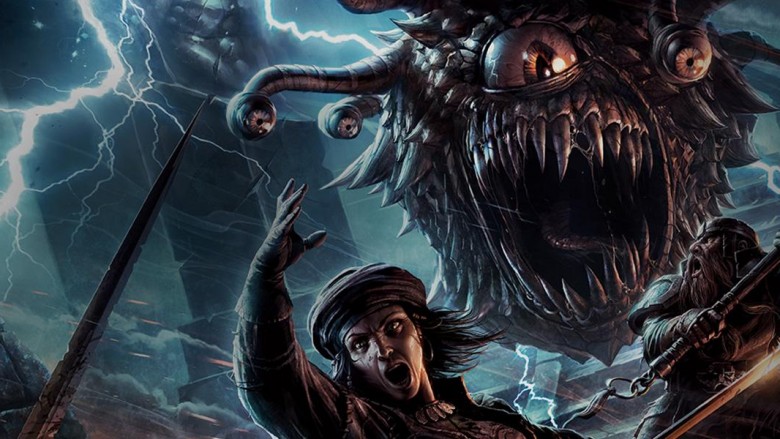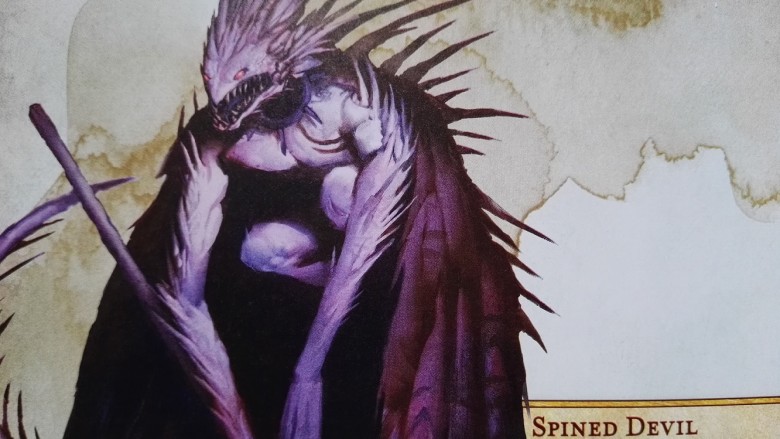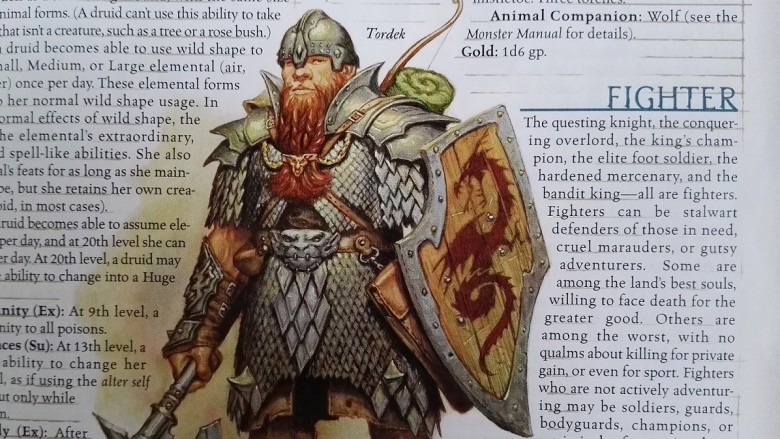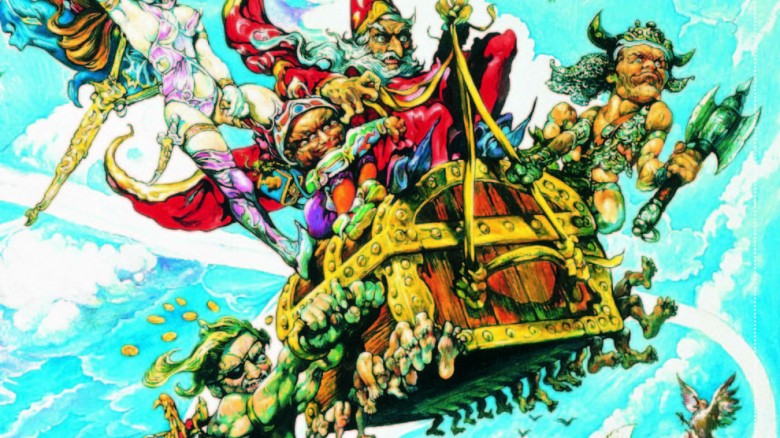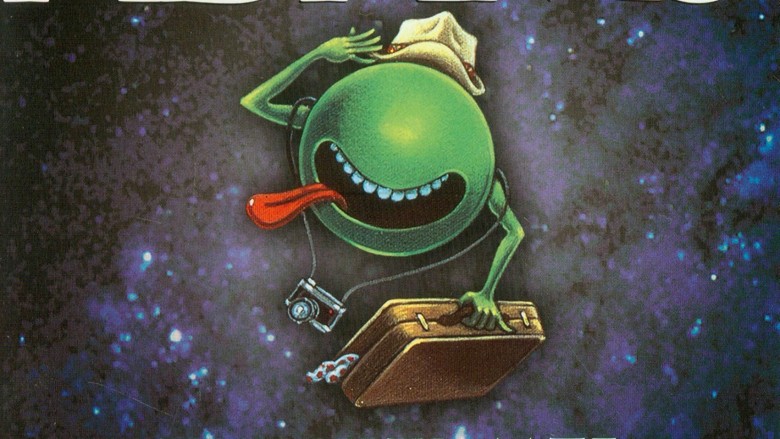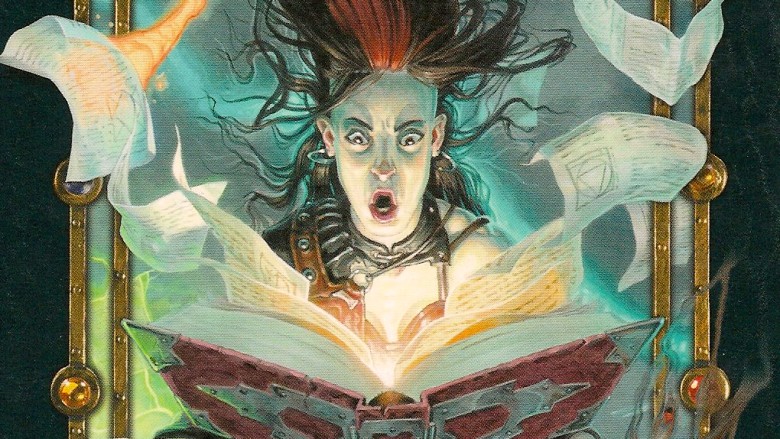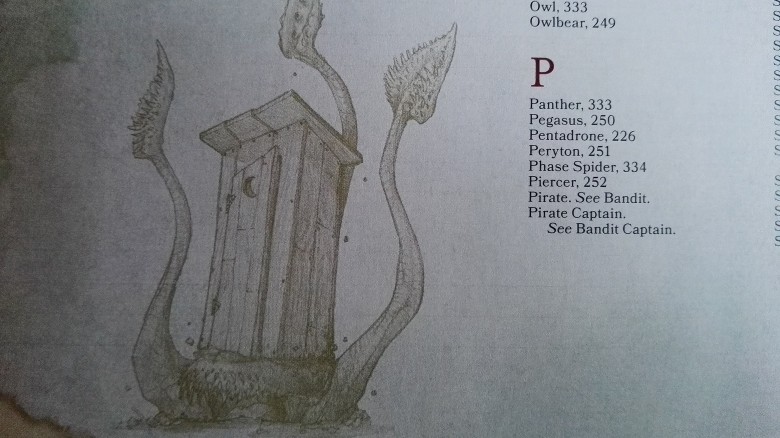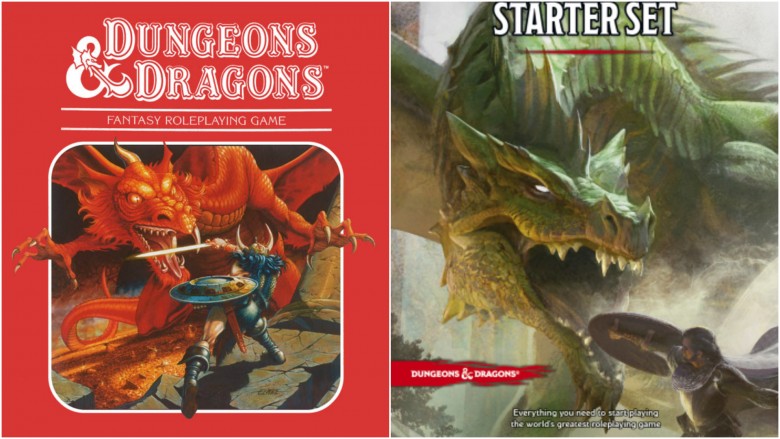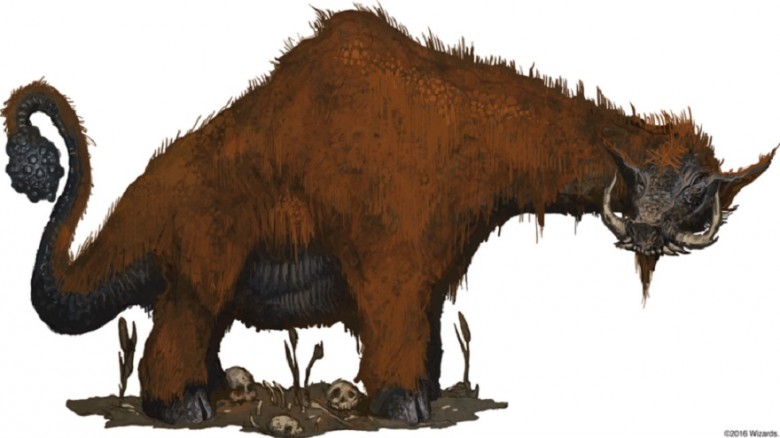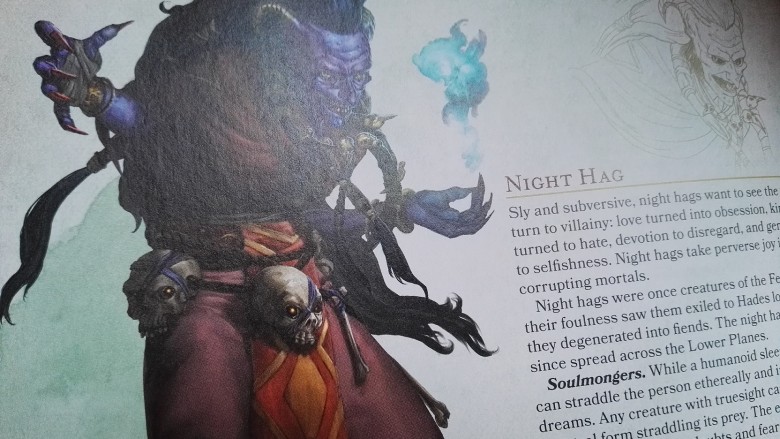Easter Eggs You Missed In D&D
We may receive a commission on purchases made from links.
Just the idea of sitting down to a marathon D&D session makes us happy. Real-life's tough, so if you get the chance to escape to a place where capes are totally stylish and you can settle arguments with a sword, what better way to spend an afternoon? Honestly, we don't want to have to come back. But no matter how many times you've cracked open a two-liter of Mountain Dew, gotten out your dice bag, and ordered your favorite pizza, you've probably missed some things in that mountain of texts you're lugging around. That's all right, because we've found some of those Easter eggs hidden in D&D for you.
WotC's liability warnings
You've probably never even glanced at the first few pages of your Player's Handbooks or Monster Manuals, and that's a shame. (We can't blame you, though — small print reminds us of real life, and we don't play D&D for real life.) Tucked away in each of the legalese is an awesome disclaimer from Wizards of the Coast, and if you're even a casual gamer, you'll get the references.
Take the 5th Edition Player's Handbook. Under the art credit, there's itty-bitty little print that says, Disclaimer: Wizards of the Coast is not responsible for the consequences of splitting up the party, sticking appendages in the mouth of a leering green devil face, accepting a dinner invitation from bugbears, storming the feast hall of a hill giant steading, angering a dragon of any variety, or saying yes when the DM asks, "Are you really sure?"
Because, as we all know, when even the DM asks you to reconsider your character's life choices, things are about to go very, very poorly for them.
They're in the Monster Manual, too, and the 5E disclaimer reads: Any similarities between monsters depicted in this book and monsters that actually exist are purely coincidental. That goes double for mind flayers, which absolutely, utterly, and completely do not exist, nor do they secretly run the D&D team. Do we really need a disclaimer to tell you that? You shouldn't use your brain to consider such irrational thoughts. They only make the mind cluttered, confused, and unpleasantly chewy. A good brain is nice, tender, and barely used. Go ahead, put down this book and watch some reality TV or Internet cat videos. They're really funny these days. You won't regret it. We say this only because we love you and your juicy, succulent gamer brain.
You get the picture. They're pretty awesome, and they're in the beginning of the modules, too. We'll wait while you go check your copies.
The Spined Devils … from the Wizard of Oz
The 5E Monster Manual is full of familiar faces, a few that probably bring back some memories, and others that probably show up in your nightmares. The Spined Devils have apparently been moonlighting during their down time, and there's a bit of flavor text by their entry that, on its own, might not mean much. But, because we know you've seen The Wizard of Oz, we know you get it.
It reads, "Fly, my pretties, fly! FLY! — Fierna, Archduchess of Phlegethos, commanding her Spined Devil Legions" It's a throwback to the flying monkeys of The Wizard of Oz and, as far as we're concerned, that makes it double nightmare fuel. It's also sort of a double Easter egg, because Fierna is someone, too. You might not remember her offhand, and trust us when we say she's someone that you ever, ever want to say that to. She's been around since the second edition, but she's only ever been a minor deity that's responsible for ruling the fourth level of Hell. That's the part with all the flames and nastiness, and she honestly makes the Wicked Witch of the West look like a Sunday school teacher.
Tordek returns
Volo's Guide to Monsters is a 5E supplement that added a whole bunch of monsters and some other fun stuff. The entire thing is presumably written by an adventurer named Volo, but it's heavily annotated by Elminster, whom you know. (If you don't know him, seriously, what are you even doing here?) Most of the notes scattered throughout the pages are from either Volo or Elminster, save a couple. Check the note for Goliath, and you'll find it's attributed to Tordek, A Guide to the Peaks.
Tordek should sound familiar, and if the name doesn't ring a bell, the face should. Way, way back in the days of 3rd Edition, the supplement text Enemies and Allies gave names, stats, and stories to all the characters they'd been using to illustrate some of the standard characters. You might call them the cliche characters, but D&D was a little more generous — they called them the Iconic Characters. Tordek is the dwarf fighter, because those were the days before equal-opportunity employment came around for the dwarf community. He's continued to show up throughout D&D lore, and now you know that guy has a name.
Nods to Terry Pratchett, Zelda, and Clue
So, you're slogging your way through a dungeon and you come across the camp of the ill-fated adventuring party that came before you. (Or, if you're like us, you're looting someone's inn room while they're down in the tavern drinking. Don't judge how we play.) Not everything you find can be treasure, and sometimes, you just need a random little trinket that certain players might even find a way to work into their character's storyline. In the 5E Player's Handbook, there's a table you can use to roll for what sort of trinkets you find.
If you roll a 45, your character is going to be handed something that should sound pretty familiar, if you're a Terry Pratchett fan (and who isn't?). The text reads: "A tiny chest carved to look like it has numerous feet on the bottom. Clearly, it's the Luggage, and clearly, your party needs to cast Animate Object immediately upon getting this one."
There's a couple of other fun things hidden in the trinkets table, too. Roll a 46 and you'll get a dead sprite in a jar (Legend of Zelda), roll a 79 and you'll get a party invitation to a notable event marked by murder (Clue), roll a 35 and you'll get a white glove covered in sequins (that may or may not have belonged to Michael Jackson), and if you roll a 34, you'll get something really weird: a little metal box with two little caps, that sparks in water. That one? A 9-volt battery.
A nod to Douglas Adams
This one's buried in one of the 5E Player's Handbook's tables, and it's easy to miss ... especially since you can play entire campaigns without ever having to look at the random table for Wild Magic Surge. If you're not familiar with it, it's a low-level sorcerer ability that causes random magic to happen, and it can be either very good, very bad, or just plain weird.
Among the weirder is a nod to Douglas Adams. Roll a 41 or 42 and you're going to find yourself turned into a potted plant when your next turn starts. You're going to stay that way, too, completely incapacitated and understandably breakable. Once you're hit enough that you do break, you'll turn back into your regular old non-planty self again. The entire thing is a blink-and-you'll-miss-it reference to the fate of the unfortunate whale and bowl of petunias from Hitchhiker's Guide to the Galaxy, and we suppose that's some sort of consolation if you suddenly find yourself turning into a potted plant. You're in good company.
Darkvision and Passwall
Ah, spell components. They're an obsession for a certain kind of DM, and the very bane of the existence of a certain kind of spellcaster. In theory, most spells have reagents you need to have, in order to be able to cast them. No reagents, no spell. Some DMs give the idea a miss, but others are fanatical about making sure their spellcasters aren't getting away with anything.
If you're not a spellcaster, or if your DM is of the more forgiving variety, you may never have bothered to look at some of the spell components. That's a pity, because some of them are pretty awesome. Darkvision, for example, is a spell that allows you to see in the dark — in order to cast it, you need an agate or a pinch of dried carrot. It's a reference to the myth that carrots are so good for your eyes that they'll help you see in the dark, and the true story behind that is a pretty epic bit of trivia in itself that involves hiding Britain's invention of radar from the Nazis.
There's also Passwall, which opens a passage through any surface for an hour. That one requires a pinch of sesame seeds, and we like to think Aladdin was actually a rogue mucking about with djinn, D&D-style.
The otyugh and the outhouse
There's no shortage of nightmare fuel in D&D, and we can't help but wonder what kind of mind came up with some of these. Take the otyugh, for example. According to the 5E Monster Manual, it's a sort of three-legged rhino with tentacles that's sporting a massive mouth, and an eye stalk you'd expect to see popping up in a garbage compactor somewhere far, far away. It's definitely not something we'd want to run into — ever — and according to the monster's description, you're not even likely to know it's there until it's too late. Its preferred habitat is underneath a pile of offal and carrion (and if you're wondering how many of those are laying around, you need to play more D&D). All that's above the piles of yuck are its eyestalk, and that's pretty gross.
That's not really the Easter egg, though — for that, you have to look on the very last page of the Monster Manual. If you check the index, you'll notice that, behind the words, there's various sketches of various things that may or may not happen in your campaign. (Poking a monster with a stick? That definitely happens.) The last one is an outhouse, with the eyestalk of an otyugh hovering above it. We know otyughs are sometimes kept as semi-tame waste disposal units, but that seems like it's overdoing it a bit. It's also a valuable reminder as to why you should just wait to find a bush.
The Starter Set throwback covers
The Starter Sets are great for newbies, and like the name suggests, they include everything you need to get hooked (we mean, "started") on D&D. The entire game has always contained some pretty epic art, and arguably the most famous is the cover of the 1983 Starter Set, affectionately just called the Red Box. It was done by Larry Elmore, and featured an impractically armored hero facing off against a red dragon. (It also lies. It took us forever to meet a red dragon, and that armor won't help you in the least.)
The 1983 set was the thing that revolutionized tabletop gaming. It made the game massively more accessible, as you didn't need to be a math wizard to play. When the 4th Edition came out, Wizards of the Coast re-released the Red Box with all the updated content. They used the same cover, and unfortunately, not many liked 4E. For 5th Edition, they took a step away from the iconic Red Box ... sort of. Unless you paid close attention to both covers, you'd miss how the 5E Starter Set cover isn't just someone fighting a dragon — it's a nifty homage to the original Starter Set that got so many people hooked on D&D in the 1980s. We approve.
The Catoblepas
Volo's Guide to Monsters introduces a whole bunch of new creatures, including the unlikely-looking catoblepas. It looks like something you actually have no reason to be afraid of, and it might even be something you'd like to try to feed a few carrots, or train to be a pack animal at least. D&D is all about thinking outside the box, after all, and if we had a gold piece for every time we tried something stupid like that, we'd have our own kingdom. Regardless, the catoblepas looks a little out-of-place among the mind flayers and beholders.
Read the description though, and you'll see it's so completely nasty, travelers will go out of their way to avoid territory where there's a catoblepas living. It has a stink "like that of death mixed with swamp gas and skunk musk," and if that's not bad enough, if it looks at you, it'll rot your flesh right then and there. It uses its tail like a club, and eats anything it kills ... rotting flesh and all.
Yikes. The description also says that, since not too many people see the catoblepas, it has something of a mythic reputation. And it really, honestly does. It wasn't just made up for D&D — it's based on a very real creature from Greek and African mythology. Pliny the Elder first wrote about the katoblepas in his Natural History, and wrote about things like its tendency to look at the ground, and its ability to kill you with its gaze if it manages to lift its head. Later writers added a bit about the smell, and it's believed the accounts were based on stories about a creature called a gnu. What kind of bad day that gnu was having, we're not sure, and we're also not sure if this gives us hope for other D&D creatures we can find in the real world ... or if we should start worrying.
Hags apparently control UFOs
Hags and witches aren't just a D&D thing — they're a staple of fantasy tradition. Volo talks a bit about the hags in Volo's Guide to Monsters, and while we won't get into details, we will say there's way more hags than you probably expect there to be. (We'd totally get into the hag business, too, if it meant driving around in a little skull car with our minions, and we really feel like we can get on board with this.)
Hags are known for collecting little trinkets and treasures and, to be fair, we've already got a pretty good start on this part of hagging. Once you defeat the hag, you might pick up a trinket or two to take along, and one of the possibilities sounds weirdly familiar. Roll an 8 on the Hag Objects table, and you'll get "An oval-shaped disc made of an unknown metal. If it is tossed in the air, it flies in circles around the tosser for a minute, tiny lights winking on its surface, before settling to the ground nearby." So ... a UFO. You straight-up collect a UFO.
We have so many questions. Are hags controlling UFOs? Does that mean there's UFOs in D&D, or that there's hags here? So, so many questions.

